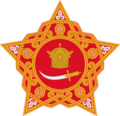Shanvan Mizarate
| Mizarate of Shanvan | ||||||
| . Šanwan Mizarāt . Shanwan Mizarât | ||||||
| ||||||
| ||||||
| Motto Şaham ṣashiyə iyem Hasağa! There is no victor but God! | ||||||
| Capital | Shanvan (1680-1757) Samadar (1757-1811) | |||||
| Languages | Koman | |||||
| Government | Absolute Monarchy | |||||
| Mizar | ||||||
| • | 1680-1696 | Tamarkhan (first) | ||||
| • | 1792-1811 | Tamshahsar (last) | ||||
| History | ||||||
| • | Consolidation | 1680 | ||||
| • | Tughan Declaration | 1811 | ||||
| • | Disestablished | 1811 | ||||
| Area | ||||||
| • | 1811 | 346,608.80 km² (133,826 sq mi) | ||||
| Population | ||||||
| • | 1811 est. | 19,453,981 | ||||
| Currency | Sekham | |||||
| Today part of | ||||||
| This article is part of a series on |
| History of Komania |
|---|
 |
| Ancient Period |
|
|
| Imperial Period |
| Warring Period |
| Modern Period |
The Shanvan Mizarate (Koman: Shanwan Mizarât [IPA]), officially the Mizarate of Shanwan, sometimes called the Ashar Mizarate, was a country bordering Vosan and Khezan to the west, the Mizarate of Samadar to the northwest, the Torosh Khanate to the northeast, ? and the Samar Holy State to the south, the Barhan Khanate to the southwest, and the Mizarate of Mishar to the east. The Shanvan Mizarate was noted for its considerable influence on bordering states, itself being ruled by a branch of the Ashar Dynasty, the country became a major player in the unification of Komania and was the dominant power during the Warring Period.
Etymology
The Mizarate derives its name from the Ashar dynasty, considered a direct descendant of the Great Horde and its successor by rule. The Mizarate itself was, as its name implies, ruled by the Ashar princes, through the direct lineage of emperor Hadjamak (1611-1642). The Shanvan Mizarate had the most immediate lineage of the Great Horde rulers previous to emperor Hadjamak.
The Mizarate was sometimes referred to as the “Ashar realm” as it constituted a collection of loose Princely States.
History
Consolidation of the Shanwan Governate
The Shanwan Governate was right after the dissolution of the Great Horde, the central power to the empire. It conformed the central region of present-day Komania as well as some additions of southern Vaniu. The governate was the emperor’s imperial domain, while it initially comprised a collection of various territories throughout the empire, it was gradually reduced to pocket lands around Torosha, Komania and [insert country]. These lands were under direct jurisdiction of the emperor and did not require an assembly or any form of autonomous administration.
Due to the loss of Samadar in 1659 at the battle of [insert name], most of the imperial court and some closely-tied nobles of the Ashar caste retreated towards Shanvan were prince [insert name] began a series of campaigns against the rival Mizarates, although most of his efforts fell into administrative obligations and the reinforcement of Shanvan as a “fortress” against posible attackers. It is noted that during his rule, he longed for the restitution of the imperial family and his proclamation as emperor, emphasizing the tragedy and disaster caused by the empire’s dissolution. The imperial family often noted their resentment towards the noble caste and the court, citing betrayal, greed and impiety as the main cause, unaware of their role during the Great Horde’s gradual demise.
